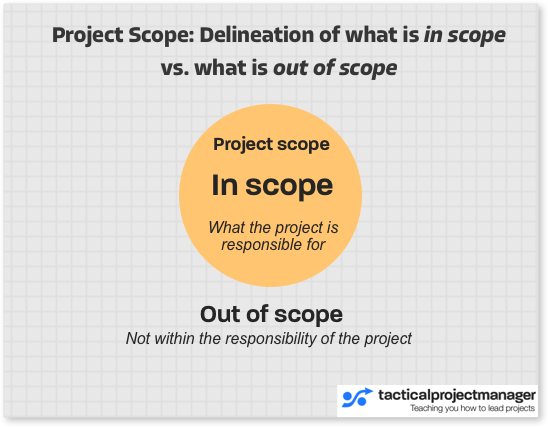In this post, I’ll clarify the concepts of “in scope” and “out of scope” — two concepts very common in project management.
As you probably know already, every project has what is called ‘scope’. Put simply, the scope defines the boundaries of a project: what the project is supposed to manage and what it should provide in terms of output.
For a deeper discussion of the concept of scope, read my article on project scope.
As project leaders, we have in-depth conversations with the client and stakeholders to establish a clear scope. We then document our agreement in writing, either in a separate scope document or in the project charter.
Enough about scope.
Let’s talk about the difference “in scope” vs. “out of scope”.
In Scope vs. Out of Scope Explained
When we say something is in scope, it means a specific task or deliverable is part of the project’s responsibilities. In other words, we have to get it done!
Take this example:
You’re managing a project to build a house. Naturally, the client wants electricity in every room. So, you’ve included electrical wiring as part of the project. You’ll handle the wiring and charge the client for the work and all the materials used. Electrical wiring is in scope.
Now let’s talk about “out of scope”.
We’ll use the house construction example again, but with the following twist:
The client is a bit of a penny-pincher, but he’s also quite handy. That’s why he wants to take on the electrical work for his new house himself. He enjoys the work and his wife appreciates it since it keeps him busy. Plus, he can save some money.
How does that change our project scope?

It means the project is no longer responsible for the electrical wiring. We can also say: Electrical wiring is out of scope and it will also be excluded from the cost estimation.
Note the following: To say that some job is ‘out of scope’ does not necessarily mean that it will be completely skipped. Like in our project example, somebody has to do the electrical wiring of the house. But if the client decides to so that wiring himself, this means electrical wiring is out of scope from a project perspective!
The following graph captures the difference between “in scope” and “out of scope”:

Scope impacts everything. Set boundaries.
The scope shapes the project in every dimension:
- It influences the effort and cost required
- It determines the choice of resources
- It sets the timeline for completion
It’s THE determining factor for any project. Before moving any further, we first must come up with a clear scope agreed by everyone.
The problem in real-life projects is that people make all kinds of assumptions about what a project is supposed to deliver (what the scope should be).
For example, a business client may assume that the custom-made machine you are building for them comes with training included.
But maybe you provide training as a separate service that the client has to book separately if he wants to learn how to use his new machine.
Thus, as a project leader you must carefully manage the scope definition, which is essentially a matter of communication, and ensure everybody has the same understanding of what the scope of a project should be.
Setting clear boundaries as to what is in scope and what is out of scope is how you get to a clear scope definition.
From there, you can derive clear requirements, make solid effort and cost estimations and plan your project in a good way, being confident that things are going to be fine!
Author
-
Hi, I’m Adrian, a Senior Project Manager and the Creator of Tactical Project Manager, where I teach a pragmatic approach to project management. Led large-scale IT and business projects for over 10 years. My goal is to enable you to lead any project with confidence.
View all posts



